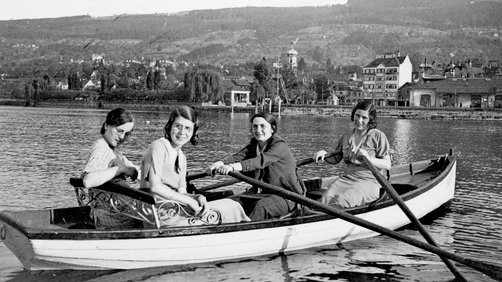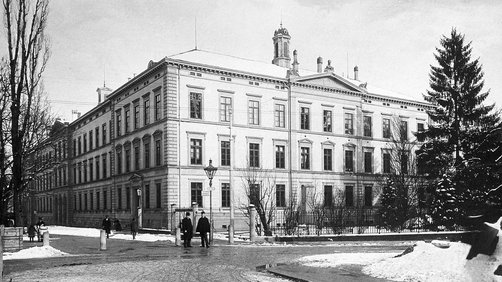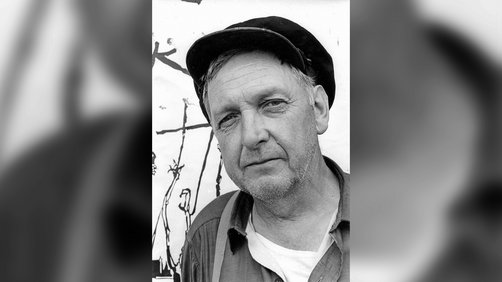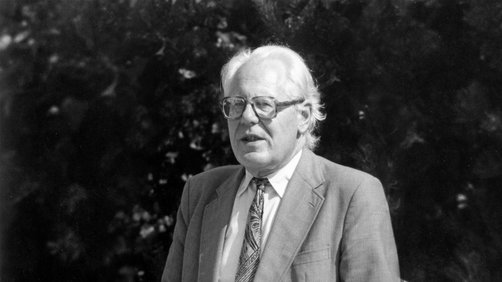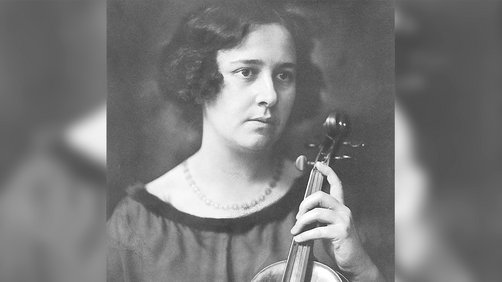Background - 25.10.2019 - 00:00
History lesson: Alicia Penalba, important representative of abstract art
As part of the artistic design of the University of St.Gallen’s newest building, Argentinian artist Alicia Penalba created an ensemble by the main staircase of the HSG consisting of eleven concrete sculptures.
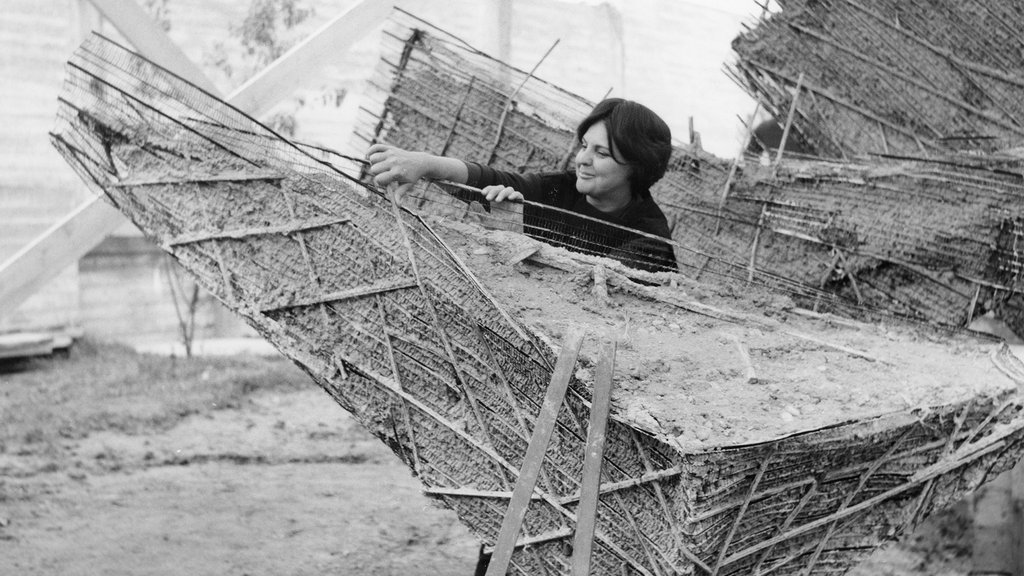
Alicia Rosario Pérez Penalba was born on 9 August 1913 in San Pedro, Buenos Aires Province, Argentina. Her parents, Santiago Pérez and Remedios Penalba, were Spanish immigrants. Her father worked as a route surveyor for the Argentinian railway. As a result, her family was forced to reside in various cities in Argentina’s Cuyo region, as well as Patagonia and Chile. While still a small child, Alicia experienced deserts, tropical forests and impressive landscapes full of contrasts.
Early emancipation
At the age of fifteen, Alicia Penalba made her first attempt to escape her close-knit family and inflexible father. A letter to the governor of the San Juan province earned her a position in the local administration. In 1929 one of her siblings committed suicide. “I resolved to break the curse of my parental home, to run away alone, as I had often dreamed of doing when I was younger; in search of total independence in what I did, with the freedom to do or not do what I wanted”, Penalba commented later. Her strong and wilful temperament would prevail against her hated father. And so she moved to Buenos Aires alone at the age of 17. From 1930 to 1934 she studied drawing and painting there at the Academy of Fine Arts. She gained attention early on as a young artist by winning several regional and national prizes.
Rise to international status
In 1948, a scholarship from the French government enabled Alicia Penalba to move to Paris. She worked for three years in the studio of Russian sculptor Ossip Zadkine at the Académie de la Grande-Chaumière. She resolved to devote herself exclusively to sculpture and in 1951 destroyed most of her early works. From 1952 onwards, the artist began developing several of the features characteristic of her style, for example, her typically totemic sculptures, which are reminiscent of petrified exotic plants. She befriended important sculptors of her generation, such as Etienne-Martin, François Stahly and Etienne Hajdu. After being shown in numerous group exhibitions, Penalba’s works were given their first solo exhibition in 1957 in Paris at the Galerie du Dragon. In 1959 she participated in “documenta II” in Kassel. Over time, ideas for a new concept of sculpture developed, characterised by a move towards an architectonic embedding of imaginary forms.
Links with the HSG
As part of the artistic design of the HSG’s newest building, Alicia Penalba was asked by Prof. Eduard Naegeli on 1 June 1960 to provide plans for a wooden sculpture. In a meeting with the Art Committee newly convened by the president, Prof. Walter Adolf Jöhr, a large sculpture made of concrete or lead was proposed on 9 September 1960 for the area in front of the main building. The idea of creating an ensemble may have arisen in 1961. Because the deciding committees were aware of the importance of the planned location, Penalba was invited to St.Gallen for an inspection.
Architect Walter Förderer reports: “During Alicia Penalba’s visit to the construction site, she suggested the idea to me. Instead of the “natural” individual sculpture I had proposed, she clearly presented to me a mediation between park and architecture by means of a plausible metaphor. “There should be shapes that the visitors’ eyes find paths between like rows of ants.” Later she used small handmade models to show me her idea in a demonstration on a cardboard box at the university.” She explained her concept as follows:
“The form, as I understand it and want to execute it, cannot resemble any object that exists – save in its un-self-aware interior, whose message of being I seek to express. (...) The only thing that matters is the arrangement, the inner relationship, the rhythm, just as music expresses itself only as a whole; if this interior, this soul is lacking, all pictorial representations of any sort of natural form are similar.”
Concrete sculptures by the main staircase
On 18 June 1962, the Board of Governors approved the commission to execute the work, with the proviso that execution could not begin until a model had been submitted and approved. In the autumn of 1962, Alicia Penalba submitted a plaster model for the concrete sculptures. And on 11 June 1963, on the basis of this model and an on-site inspection, the Senate Committee awarded a commission to create the sculptures by the main staircase. The contract was signed in June 1963.
From the end of August to the beginning of November 1963, Alicia Penalba created the ensemble of eleven concrete sculptures. These sculptures are made of the same material as the walls behind them, only with a more coarsely grained texture. Spread across the lawn in a free and dance-like rhythm, the group of figures was conceived as a flowing transition from the natural park to the brutalist style of the new HSG building designed by the architects Förderer, Otto and Zwimpfer.
Important representative of abstract art
In the 1960s, Alicia Penalba’s work achieved international recognition. In 1961, she received the grand prize for sculpture at the São Paulo Art Biennial (Brazil). Galleries and museums around the world began taking an interest in her work, including those in New York, Rio de Janeiro, Zurich, Rome, Milan and Eindhoven. From 1964 onwards, Penalba possessed her own workshop in the Marais district of Paris. That same year, she exhibited new works at “documenta 3” in Kassel. She began creating monumental works. At the same time, an individual approach to a redefinition of sculpture emerged with the “Formes volantes”, flying forms set directly on walls. The major retrospective “Totem and Taboo”, organised in May 1968 by the Musée d’Art Moderne de la Ville de Paris (together with Wifredo Lam and Roberto Matta) cemented Penalba’s international reputation.
Works of the 1970s
Penalba’s work in the 1970s was characterised by the creation of monumental works for sculpture parks in a number of countries including France, Belgium, Germany, Argentina and the US. At the same time, she also produced smaller sculptures and experimented with lithography, collage, tapestry, porcelain design and jewellery. In 1974 she was awarded the Gulbenkian Foundation prize. She signed all of her works without exception with only her mother’s name: Penalba.
Alicia Penalba died with her partner Michel Chilo in a car crash on 4 November 1982 in the vicinity of Dax, France.
History portal of the University of St.Gallen
More articles from the same category
This could also be of interest to you
Discover our special topics



![[Translate to English:] Choix Goncourt de la Suisse | unisg.ch](https://www.unisg.ch/fileadmin/_processed_/b/a/csm_Choix_Concourt_de_la_Suisse_HT-Stibi-069_2110740678.jpg)

